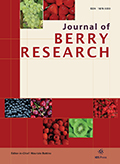Authors: Cocco, Carine | Faedi, Walther | Magnani, Sabina | Maltoni, Maria Luigia | Stagno, Fiorella | Turci, Patrizia | Quacquarelli, Irene | Ferré, Anne-Sophie | Baruzzi, Gianluca
Article Type:
Research Article
Abstract:
The winter planting system is based on the use of the bare-root plant. It is used extensively in many strawberry cultivation areas characterized by mild winters. Bare-root plants have disadvantages and plug plants represent a valid alternative to the traditional bare-root plant. This study, conducted in Southern Italy, investigated the changes in the fruiting cycle of bare-root and plug plants of strawberry (Fragaria × ananassa ), with a focus on fruit quality. Bare root and plug plants for three strawberry genotypes were planted in fields and the differences in yield, quality traits and main bioactive compounds were evaluated. The
…plants were grown in Scanzano Jonico – Basilicata region (Southern Italy). Yield per plant, fruit size, total soluble solids content, titratable acidity, flesh firmness, skin colour, antioxidant activity (TAC), total phenols (TPH), total anthocyanins (TACY), ascorbic acid content (AA) and phenolic profile were determined. The results confirmed that the start of the harvest for plug plants was significantly earlier than for bare-root plants and plug plants also had higher productivity. The fruit size of plug plants was initially larger than for bare root plants but became significantly smaller when the production flow decreased in May. Plant type did not affect flesh firmness, while the sugar content was lower in plug plants. The fruit colour brightness was higher for plug plants in the first part of the harvest but reduced significantly in the second part. TPH was lower for plug plants, compared to bare-root plants, in the first part of the harvest but higher in the second part, when the fruit size of plug plants decreased significantly. TACY showed a considerable variability and was more influenced by the genotype rather than by the type of plant. Also, TAC, being correlated with TPH, had higher values in plug plants in the second part of the harvest, coinciding with the decrease in size. The content of the most important classes of individual polyphenols (anthocyanins and ellagitannins) was on average higher in plug plants than in bare-root plants. In summary, the plug plant had an early yield start with a production concentrated in March and early April, which is suitable for Mediterranean areas, but the quality traits showed a lot of variability from year to year. Keywords:
Show more
Keywords: Antioxidant capacity, genotype, type of plant, F. x ananassa, nutraceutical properties
DOI: 10.3233/JBR-190389
Citation: Journal of Berry Research,
vol. 10, no. 2, pp. 145-156, 2020





